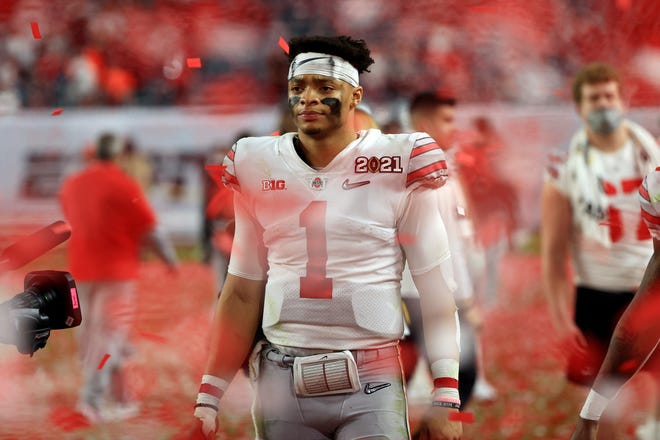
MIAMI GARDENS, Fla. — After one half at Monday night’s College Football Playoff national championship against Alabama, it became clear that Ohio State’s path to victory hinged on a miracle or, barring that, the Crimson Tide becoming lost in the tunnels below Hard Rock Stadium and unable to return for the third quarter, giving the Buckeyes the title by forfeit.
The Tide found their way back. For the Buckeyes, the second half wasn't much better.
"Tough night, tough night," said Ohio State coach Ryan Day. "We needed to play our best game tonight against Alabama. And we didn’t."
There are two distinct classes in college football: the four or five programs capable of winning the championship in any given year, a list that includes Alabama and Ohio State, and then everyone else.
Alabama’s 52-24 win suggests there’s a split even within that elite group — or at least one separating the Crimson Tide and the Buckeyes.

More:Opinion: Nick Saban and Alabama appear untouchable after securing sixth national title
More:DeVonta Smith's record-setting performance lights up CFP national championship before injury
With the exception of a brief span through the first quarter and early into the second, Alabama put Ohio State into a blender and pureed the Big Ten champions, who went from the high of beating Clemson in the national semifinals to the low of being humbled on the biggest stage the sport has to offer.
"I think we’re the best team to ever play," said Alabama quarterback Mac Jones. "We’re so glad to win this game and put the icing on the cake."
After converting on an Alabama turnover deep in its own territory to tie the score at 14 with 11:43 left in the second quarter, Ohio State was blitzed by an Alabama run that will go down in postseason history, a 21-3 surge to end the half ahead 35-17. Put into a deep hole, the Buckeyes' offense was unable to get into a rhythm and make up ground in a game that had drifted out of control.
Given the stakes, the performance of the Buckeyes' defense will go down as the worst in program history.
The numbers speak for themselves: Alabama gained 621 yards on 83 plays, 157 on the ground and 464 through the air, with 33 first downs. The yardage was the most OSU had given up in a single game since allowing 603 to Michigan in 2016. Alabama's 52 points set a playoff championship game record and were the most OSU has ever allowed in the postseason.
"We wanted to make sure we didn’t change what we do, just fundamentally. But we also had to have some changeups because if you just sit there they’ll pick you apart," said Day. "Clearly, it wasn’t good enough."
Junior quarterback Mac Jones finished with 36 completions for 464 yards and five touchdowns, tying a playoff championship game record for completions and setting a new mark for yardage.
Running back Najee Harris had 79 yards on 22 carries, another 79 receiving yards and three scores, giving him 30 touchdowns on the year to set an Alabama and SEC single-season record.
And wide receiver DeVonta Smith, this year's Heisman Trophy winner, accounted for 12 receptions for 215 yards and three scores before leaving the game in the third quarter with an injury to his right hand, setting a slew of single-game and career SEC, program and playoff records.
More:Relive Alabama football's historic national championship run with a special book
There might be an excuse for falling flat: Ohio State was down two starters on the defensive line, negating a team strength when facing the nation's best offensive front. Alabama's easy path to 52 points suggests OSU would've struggled even at full strength.
Schematically, the Buckeyes were left at a loss. Alabama's game plan created mismatches in the passing game, most notably on a 42-yard touchdown pass to Smith in the second quarter that saw the senior pitted against linebacker Tuf Borland. When the Buckeyes would counter, Alabama would slide Smith into motion and force Ohio State defenders to make plays in space.
"They had a great scheme," said Ohio State cornerback Shaun Wade. "They just made plays. They just came out and outplayed us."
With running back Trey Sermon out after suffering an injury on the game's first possession and the Crimson Tide pulling away, OSU was forced to toss aside the offensive balance that had defined the win against Clemson.
In what is expected to be his last college game, junior quarterback Justin Fields finished with 17 completions in 33 attempts for 194 yards and a touchdown with 67 rushing yards. If not as culpable as the Buckeyes' defense, the offense stood in contrast to Alabama's deep and explosive group, particularly with Sermon sidelined.
"I feel like they did a good job executing on defense," Fields said. "Of course they have great players, great athletes and they have a great defensive coordinator, so they did a good job doing that."
There is pride to be had in reaching the championship game, especially during a unique year plagued by COVID-19 outbreaks, canceled games and, for OSU in particular, a start-and-stop road through the regular season.
But here's how it ended: For one night at Hard Rock Stadium, Alabama made the Buckeyes look like the rest of college football — outmatched and devoid of any answers against a superior opponent.
"When you’re playing against elite players, and this is probably one of the better offenses in a long time, the margin for error is tiny," Day said.
Source link









